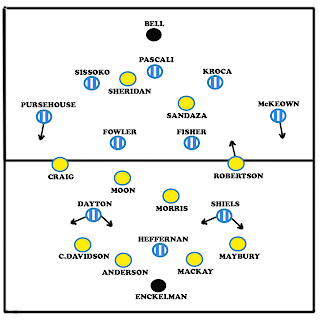Rangers put in another excellent defensive display away from home and
continued their remarkable run of six wins from six on the road, scoring
fourteen and failing to concede in the process.
It was a rather drab performance from Hearts, although they could have
levelled at 1-0 had the ball fallen to a more composed striker of the ball
than Adrian Mrowiec midway through the second half.
Ally McCoist changed the shape of his side for this visit to
Tynecastle, ditching his usual 4-4-2 in favour of a 4-4-1-1, which matched Hearts
man-for-man in the centre of the pitch - something
Neil Lennon failed to execute in Celtic’s recent defeat at the same ground.
Another notable feature of the Rangers formation saw two left-backs
start on the left – Sasa Papac was deployed at left-midfield – and Maurice Edu
moved out to the right of midfield.
Hearts have gained a fair amount of success from their advancing
full-backs this season and the use of two defensive-minded players as their
direct opponents, as well as a three-man central midfield, displayed McCoist’s willingness
to prioritise stopping his opponents from playing.
There was little to note about the Hearts formation. For the third successive match, Paulo Sergio
fielded the same starting eleven in a 4-3-3 formation.
Scrappy first half
Hearts dominated the early stages of a first half more noteworthy for
its stop-start nature and cynical fouls than any football on display. Steven Whittaker picked up an early booking
and was perhaps lucky to stay on the pitch after a late foul on David
Templeton.
This came after he had helped his side take the lead, however. The former Hibernian full-back collected the
ball from Edu around the halfway line and drove towards the Hearts penalty
area. He evaded the challenge, or lack
thereof, from no fewer than four Hearts players before feeding Steven Naismith,
who struck the ball through the legs of the advancing Marian Kello.
Naismith started the match just off Kyle Lafferty in attack and was a
handful for the Hearts defence all afternoon through his movement and
intelligent off-the-ball runs. Eggert
Jonsson was the man tasked with man-marking the Scotland international but, for
the goal, allowed him to slip free when attempting to stop the run of Whittaker. Naismith darted into space and finished for
his eighth of the season, taking him to the top of the scoring charts.
Hearts then finished the half the stronger side, as they had started
the match, but failed to trouble Alan McGregor in the Rangers goal, with the
exception of a long-range Rudi Skacel effort.
Rangers, as they have done for many of their away matches this season,
sat on their lead and attempted to hit their opponents on the counter attack.
Second half
Rangers’ focus was to get as many men behind the ball as possible for
the vast majority of the second half, allowing Hearts plenty of possession. Hearts managed to carve out two great
opportunities – one at 1-0, another at 2-0 – but for all their possession they,
for the most part, struggled to break Rangers down.
The main reason for this, mentioned earlier, was the set up of the
Rangers side. Hearts had little joy down
the flanks due to the presence of Edu and Papac as auxiliary wide-midfielders. The Hearts full-backs rarely threatened in
advanced areas and both had poor matches, especially Danny Grainger.
Further to this, Hearts were denied space in the centre of the pitch
and were rarely able to work the ball through central areas. Sergio waited until almost eighty minutes had
elapsed before making a substitution, sending on Mehdi Taouil for Jonsson. Taouil is the type of player that can take
the ball into feet and find a pass or take the ball past opponents when space is
at a premium and it is a change the Hearts manager maybe should have considered
making much earlier in the match.
A final reason for the poor performance was the decision-making of some
of the Hearts players. They often
elected to play a long ball, a long diagonal pass or a switch of play when
there was often a much simpler, shorter passing option available. On several occasions a Hearts player would
make themselves available for a pass in the centre of the pitch yet were
ignored. The Hearts full-backs were
particularly guilty of this and Skacel was one player who became visibly frustrated
with his teammates.
This is not to take anything away from the Rangers performance. Knowing
the recent form of Hearts at Tynecastle, McCoist intelligently set up his side
to stop their opponents and made the right changes at the right time.
After a spell where Hearts greatly dominated possession, McCoist responded
by sending on Nikica Jelavic and Gregg Wylde for Lafferty and Papac. Not only did this produce a goal within three
minutes – Carlos Bocanegra picking out Jelavic with a ball over the top of the
Hearts defence – it gave Rangers two extra players to target in the final third
that could keep the ball in advanced areas something Lafferty had failed to do
in his seventy-odd minutes on the pitch.
Conclusion
Without doubt, McCoist won the tactical battle from start to
finish. Stopping the Hearts full-backs
from influencing the game and matching the home side man-for-man in the centre
of midfield meant Hearts were largely ineffective and, with players like
Naismith in attack always likely to finish one of his side’s chances, it culminated
in a very efficient performance from the champions.
Hearts shouldn’t be too discouraged from their performance. Even though they didn’t create much and were
woeful in front of goal when they did, they were simply defeated by a better
side with a better strategy. The one
worrying thing from a Hearts point of view was their manager’s lack of a plan B
and hesitancy in making changes earlier.


